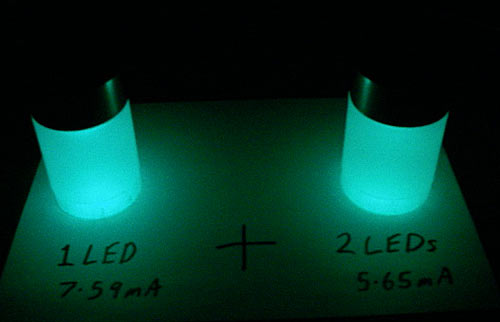A reader writes:
Myself and a friend were just reading Big Clive's "Hack your solar garden lights", and we are unsure how he came to those amp readings and the conclusion that two LEDs use less amps than one.
I am assuming we are just missing something, could you please enlighten us?
Daniel
To oversimplify, two LEDs in series have more resistance, so less current flows. But halving the current passing through an LED doesn't necessarily halve its brightness. Standard high-brightness 5mm LEDs generally have a 20-milliamp current draw on the spec sheet, but will glow from much less, and may be considerably more efficient at small currents.
The reason why this is an oversimplification is that LEDs, unlike incandescent-filament lamps, aren't just a relatively simple resistive device.
(And the "relatively" is in that sentence because not even tungsten-filament bulbs are completely straightforward. They have, for instance, a much lower resistance when cold than when operating. And reducing the power of a filament bulb will generally give you a reduction in apparent brightness that's greater than the reduction in power, because the filament will be cooler and more of its output will be down in the invisible infrared. LEDs, in contrast, only know how to make one colour, even when they're only barely creating a tiny spark of light. This is the case for white LEDs too, because to date all of those are actually blue LEDs with a phosphor coating that turns some of the blue light into other colours.)
Instead of being resistors, Light Emitting Diodes are, yes, diodes, with a constant voltage drop across them at a given temperature. But when they're lit they get warmer, causing them to pass more current and glow brighter and get warmer again, which can rapidly lead to destructive thermal runaway unless the LED is restrained in some way, by for instance limiting the source voltage so the LED will just never be able to get hot enough. Or, more commonly, by limiting the maximum possible current.
You can see how this can get complicated. (Power-supply design in general is a surprisingly tricky field.) Just running LEDs from a simple DC source via current-limiting resistors can be a bit complex; proper efficient LED drivers that deliver a set current no matter what LED you plug into them are more complicated again. (The drivers in garden lights are elegant, but like the "joule thief", not actually very efficient.)
Don't let all this put you off monkeying with garden lights, though; as Clive says, they're both easy to modify and so cheap that it doesn't matter if you wreck something. Just add some of the incredibly cheap high-brightness LEDs you can get nowadays (which I mentioned the other day), and you can make all sorts of decorative, and even useful, solar LED lights for close to no money at all.

4 May 2012 at 3:27 pm
Thanks for the quick answer on that mate,
Makes sense now that it has been explained.
Now off to buy some solar lights i Saw Big-W had some on sale :)
Daniel